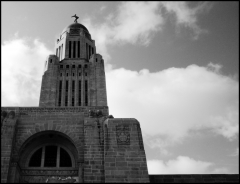
The Nebraska State Capitol was originally designed to house all offices of state government. As government has grown through the years, the service agencies, such as Health, Education and the Department of Roads were moved to auxiliary sites in Lincoln. Currently the three branches of government and their immediate support staff are located within the Capitol. The Executive, Legislative and Judicial branches are located within the separate quadrants of the Capitol’s base. The northeast quadrants of 1st and 2nd floor are occupied by the Executive Branch, the southeast quadrants of the 1st and 2nd floors are occupied by the Judicial Branch, and the Legislative branch generally occupies the west half of the building’s base. Various administrative, advocacy and service agencies which remain in the Capitol are housed in the tower.
When the Capitol was completed in 1932, Nebraska had a bicameral legislature with the Senate and House of Representatives meeting in the newly constructed East and West Legislative Chambers. In 1934, the citizens, under the guidance of United States Senator George W. Norris from Nebraska, voted and changed the constitution, adopting the one-house unicameral legislative system. Upon adoption of the Unicameral, the larger West Chamber was chosen to house the new body. The West Chamber was named the George W. Norris Legislative Chamber in 1984 in recognition of his contribution to Nebraska’s unique legislative system.
The Capitol was designed with two courtrooms to meet the needs of the Judicial branch of government. The Supreme Court of Nebraska has met in the Capitol since its completion in 1932. However, it was only after the citizens voted in 1990 to amend the constitution of the state to allow for an intermediary Court of Appeals that the second courtroom in the Capitol began to be used.
The Capitol contains the administrative offices of the Court, as well as judges offices.